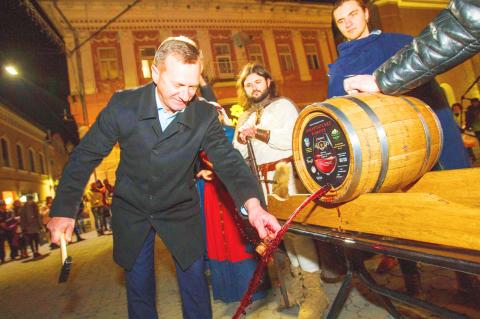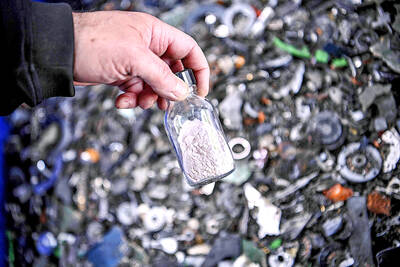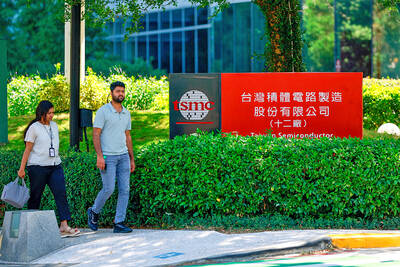Oleksandr Kovach takes a glass, swirls the wine a few times and raises it to eye level before taking a sip.
The 47-year-old vintner in the Transcarpathia region of western Ukraine is holding a wine tasting for tourists at his vineyard in the region’s largest city, Uzhhorod.
Kovach leads visitors to his softly-lit wine cellar, where a wooden table set with glasses awaits as mood music plays in the background.

Photo: AFP
He has doubled production of his own-label Kovach’s Wines in five years, and believes this is just the beginning.
Ukraine’s wine industry is enjoying a revival and branching out into more sophisticated wines after suffering a devastating blow from Russia’s annexation of its main vineyards in Crimea.
When Moscow seized the Black Sea peninsula in 2014, Ukraine lost more than half its bottled wines, mostly semi-sweet and dessert wines, the Association of Winegrowers and Winemakers of Ukraine said.
However, the loss of Crimea and the armed conflict in the east ironically gave a giant push to Western-style dry wines, especially in Transcarpathia and the southern Odessa and Kherson regions.
Since 2015, Ukraine’s production of dry wines has grown by 7 percent to 9 percent every year, the association said.
“This is a huge leap forward,” said Kovach, who now produces 30 varieties of wine, only six of which are sweet.
The winemaker believes that Ukraine has “finally got rid of” its Soviet legacy of sweet wines while adapting to “European standards.”
Exports of non-sparkling wines have more than tripled since 2014 to 332,000 deciliters last year, the association said.
“When the first wine festival was held here [in Transcarpathia] in 1995, few winemakers even differentiated red and white wine,” Kovach said. “The grapes just grew by themselves, people collected them and processed them without understanding what they were doing.”
Transcarpathia is reviving grape varieties destroyed by Soviet collectivized agriculture, said Vasyl Nad, a 54-year-old winemaker in Beregove, a small town near the Hungarian border.
“This land has an advantage — a special microclimate where the temperamental European varieties do well,” said Nad, who runs Nota Bene winery.
The forested and mountainous region is known for its dry white wines made from the Riesling, Gewuerztraminer and Leanka grape varieties.
Now Transcarpathia holds nine wine festivals attended by about 150,000 tourists per year, the regional tourist information center said.
They especially draw wine lovers from Slovakia, Poland, Hungary and the Czech Republic to the region, which also offers skiing and hot springs.
For Ukrainians, a renewed interest in local wine is at least partly explained by politics. After Russia-backed rebels sparked a long-running armed conflict in the east, many Ukrainians started buying local brands to support the shaky economy.
“Four years ago, our people didn’t know winemaking even existed in Ukraine,” said Sergiy Klimov, owner of the Like a Local’s wine bar in Kiev — the city’s first to offer a large selection of exclusively Ukrainian wines.
“When the public’s general interest grew, things started developing,” he added.
“Thank God, the wine culture is coming back to Ukraine,” said 32-year-old Gergey Paraska, whose family of Hungarian origin has made wine for six generations.
Together with his brother, he is restoring the family’s winery in Bene, a small village in the foothills of the Carpathian Mountains.
Paraska’s great-grandfather was exiled to Siberia and his vineyards were destroyed during the Soviet repression of peasants in the 1920s and 1930s.
When he returned, he got his three sons together and dictated to them the family’s secret recipes for 35 wines, which he still remembered.
Paraska and his brother have revived 18 of those family wines, which they sell under the Paraszka Pinceszet label.
In the next five to 10 years, Ukrainian wine will show “tremendous growth,” Klimov said. “We have varieties that are typical only of Ukraine and they are unique.”
The devaluation of the Ukrainian hryvnia has helped local wines compete against inexpensive Chilean, Argentine, French and Italian wines.
An average bottle of Ukrainian wine costs about 100 to 200 hryvnia (US$3.83 to US$7.66).
“When the buyer chooses between imported wine for 3 euros and Ukrainian wine for 3 euros, he understands ... what the quality is,” Klimov said.
However, small wineries face bureaucratic obstacles.
Only 50 large Ukrainian companies are licensed to sell wine, and winemakers such as Paraska and Nad can only sell their product in their own tasting rooms.
Winemakers have said it is hard to obtain a license in a country fraught with corruption.
“You have to collect 136 documents from seven ministries and pay US$10,000 in bribes in order to buy a license that costs 780 hryvnia,” Kovach said.
Yet, they believe the future of Ukraine’s winemaking is with small manufacturers.
“Wine with real flair, something true and powerful, can only be created in small family wineries,” Nad said. “This is where the person invests as much as possible — both his labor and his soul.”

RECYCLE: Taiwan would aid manufacturers in refining rare earths from discarded appliances, which would fit the nation’s circular economy goals, minister Kung said Taiwan would work with the US and Japan on a proposed cooperation initiative in response to Beijing’s newly announced rare earth export curbs, Minister of Economic Affairs Kung Ming-hsin (龔明鑫) said yesterday. China last week announced new restrictions requiring companies to obtain export licenses if their products contain more than 0.1 percent of Chinese-origin rare earths by value. US Secretary of the Treasury Scott Bessent on Wednesday responded by saying that Beijing was “unreliable” in its rare earths exports, adding that the US would “neither be commanded, nor controlled” by China, several media outlets reported. Japanese Minister of Finance Katsunobu Kato yesterday also

Jensen Huang (黃仁勳), founder and CEO of US-based artificial intelligence chip designer Nvidia Corp and Taiwan Semiconductor Manufacturing Co (TSMC, 台積電) on Friday celebrated the first Nvidia Blackwell wafer produced on US soil. Huang visited TSMC’s advanced wafer fab in the US state of Arizona and joined the Taiwanese chipmaker’s executives to witness the efforts to “build the infrastructure that powers the world’s AI factories, right here in America,” Nvidia said in a statement. At the event, Huang joined Y.L. Wang (王英郎), vice president of operations at TSMC, in signing their names on the Blackwell wafer to

‘DRAMATIC AND POSITIVE’: AI growth would be better than it previously forecast and would stay robust even if the Chinese market became inaccessible for customers, it said Taiwan Semiconductor Manufacturing Co (TSMC, 台積電) yesterday raised its full-year revenue growth outlook after posting record profit for last quarter, despite growing market concern about an artificial intelligence (AI) bubble. The company said it expects revenue to expand about 35 percent year-on-year, driven mainly by faster-than-expected demand for leading-edge chips for AI applications. The world’s biggest contract chipmaker in July projected that revenue this year would expand about 30 percent in US dollar terms. The company also slightly hiked its capital expenditure for this year to US$40 billion to US$42 billion, compared with US$38 billion to US$42 billion it set previously. “AI demand actually

RARE EARTHS: The call between the US Treasury Secretary and his Chinese counterpart came as Washington sought to rally G7 partners in response to China’s export controls China and the US on Saturday agreed to conduct another round of trade negotiations in the coming week, as the world’s two biggest economies seek to avoid another damaging tit-for-tat tariff battle. Beijing last week announced sweeping controls on the critical rare earths industry, prompting US President Donald Trump to threaten 100 percent tariffs on imports from China in retaliation. Trump had also threatened to cancel his expected meeting with Chinese President Xi Jinping (習近平) in South Korea later this month on the sidelines of the APEC summit. In the latest indication of efforts to resolve their dispute, Chinese state media reported that